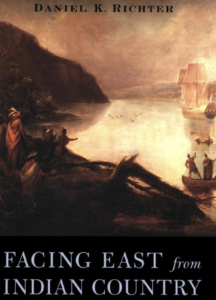I received my review copy of Daniel K. Richter’s recent book, Facing East from Indian Country: A Native History of Early America, at that point late in the semester when textbook publishers had begun bombarding me with the latest editions of their books and other supplementary materials for the United States history survey course. Though the narratives included in these works remain quite traditional, and Indians remain bit players in what is still largely a story of the plantation and expansion of English societies in America, these texts are far superior to those I was assigned as an undergraduate in the mid-1980s. They include more illustrations. More attention is paid to the role played by Indians in the historical development of the American colonies and the early American republic. In the short bibliographies that accompany each chapter, the authors in general demonstrate their familiarity with the exciting scholarship that has been published over the course of the last two decades by historians working in the field of early Native American history.
Daniel Richter’s important synthesis of this scholarly output no doubt will be incorporated into the lists of suggested readings that these authors place at the end of their first few chapters. They will, I suspect, be unlikely to do much more than that, for to truly act on the insights of Richter’s book would require a revolutionary change in perspective, and an entire recasting of the story of early American history.
Richter confronts in Facing East the fundamental challenge every scholar writing the early history of Native Americans must face: how can we, with evidence that at best is incomplete and that often is tainted with the ignorance, hostility, bias, and prejudice of its creator, arrive at an understanding of early American history from the perspective of Indian peoples? How can we incorporate native views of the events that brought such dramatic change to Indian communities into the broader narrative of American history? Richter is honest. “Perhaps no historical subject requires more imagination,” he writes, than the reconstruction of the Indians’ understandings of the newcomers who rapidly began to reshape their world in the sixteenth century. “Documentary evidence,” he points out, “illuminates the European cast of characters, yet only imagination can put Indians in the foreground.” With imagination and, importantly, an ability to read with sensitivity and subtlety the surviving strands of evidence—archaeological, anthropological, and historical—Richter demonstrates just how much a skilled and careful scholar can do.
In Richter’s recasting of early American history, the familiar figures of Pocahontas and Kateri Tekakwitha, for instance, no longer are viewed as Indians who abandoned their native cultures and accepted, respectively, the benevolence of the Virginia Company of London and the teachings of Jesuit priests. Their apparent acceptance of European religious values, when viewed from Indian country, reveals that Indians acted on motivations that often entirely escaped or remained poorly understood by their would-be benefactors. Nor, Richter argues, can Metacom, the leader of the massive Algonquian uprising that set New England’s frontiers ablaze in 1675-76, be viewed as the desperate opponent of all things English, a “patriot chief” trying to protect his people and his culture from Puritan aggression. Metacom, Richter points out, willingly assumed an English name, Philip, and he and his Wampanoag followers raised hogs. He was thus “not a rebel against cultural change or against the English presence per se.” Indians responded to the European invaders in complex ways, based on systems of cultural values and beliefs that the newcomers treated with condescension, scorn, and contempt. Nonetheless, by reading and examining carefully the extant historical sources, and arriving as thoroughly as possible at an understanding of the cultures described and recorded imperfectly therein, Richter shows that the effort to transform the traditional narrative of American history from one of the westward expansion of white settlement to one that looks eastward from Indian country is not only possible, but essential for understanding this nation’s past in all its complexity.
Many of our undergraduate students, no doubt, relying on the coverage of early American history in their textbooks, will continue to view Native American history in a simplistic and dichotomous fashion: Indians either resist heroically until they are defeated, conquered, and disappear, or they assimilate entirely into the increasingly dominant European-American culture. Richter shows in this fine and thought-provoking book, one that is written gracefully enough so that beginning students in the survey will have no trouble reading and discussing the important issues it raises, that it is possible to free ourselves from the interpretive constraints that a European-dominated and westward looking narrative has imposed on our understanding of the history of this continent.
This article originally appeared in issue 3.3 (April, 2003).
Michael Leroy Oberg is associate professor of history at SUNY-Geneseo, and the author of Uncas: First of the Mohegans (2003) and Dominion and Civility: English Imperialism and Native America, 1585-1685 (1999), both published by the Cornell University Press.



















